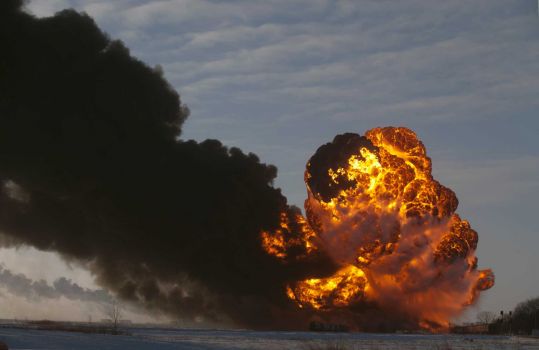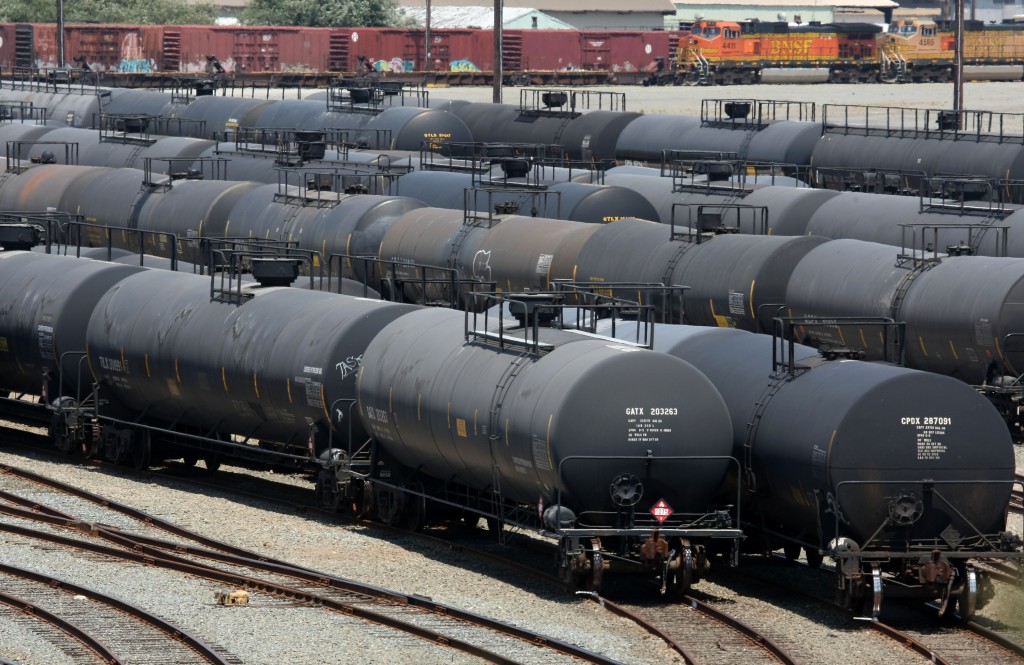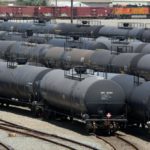A surge in rail transport has accounted for hundreds of thousands of gallons of spilled crude oil, more than the previous four decades combined. Ross Hammond from ForestEthics outlines five immediate actions for President Obama on train safety.


Everyone is on the Wrong Side of the Tracks
By Ross Hammond, Published By ForestEthics
Oil trains give new meaning to living on the “wrong side of the tracks.” This summer ForestEthics released our blast zone map, an online tool that uses Google maps and rail industry data to let you see if your home, school, or office is inside the one-mile evacuation zone in the case of an oil train derailment and fire. We used census data to calculate that more than 25 million Americans live within this dangerous blast zone.
httpvh://youtu.be/WpXfQMFR_Qs
The Crude Gamble of Oil by Rail: Bomb Trains – Vice News
Fracked Oil Bomb Trains? Note the July 2013 disaster in Lac-Megantic, Quebec, when a failed braking system sent a train carrying fracked oil from North Dakota’s Bakken shale formation roaring into the heart of town where it derailed, exploded and killed 47 people. Furthermore, last year, railroads carried more than 400,000 carloads of crude oil, up from 9,500 in 2008, when the fracking boom began. As shipments have increased, so have derailments and fires. Five occurred in 2013 and five have already occurred this year. In early May, a train derailment in Colorado spilled thousands of gallons of crude oil into groundwater, less than two weeks after a derailment in Lynchburg, Virginia spewed flames and thick black smoke into the air, poured oil into the James River and forced evacuations. — EcoWatch
On September 30th ForestEthics and our partners submitted detailed technical comments on the administration’s proposed new safety standards for oil trains. The standards miss the mark in many ways, but there are five immediate actions the administration needs to take to fix these proposed rules before they finalize them next year:
1) An immediate ban on the transport of crude oil in dangerous DOT-111 rail cars. The proposal gives the oil and rail industry as long as seven years to take volatile tanker cars off the tracks. In 1991 federal rail safety officials first declared these tanker cars unsafe to carry crude oil because they too easily derail, spill, and catch fire. Seven years is far too long to wait to remove rail cars that have been called the Ford Pinto of the rails. That’s why we’re suing the Obama Administration to take those cars of the rails right now.
2) Provide an accurate assessment of the risks and consequences of crude oil accidents in highly populated areas and to critical drinking water supplies. The administration used accounting tricks to reduce their estimate of the likelihood and severity of “high consequence accidents” and the potential costs, in lives and dollars, of an oil train derailment, spill, or fire. The oil and rail industries need to treat oil trains as the dangerous threat to public safety, drinking water, and wildlife that they are.
“It’s kind of amusing when I read in the paper that there’s this angst and gnashing of teeth about Keystone and I’m going, ‘My goodness, we’re already there [Port Arthur, Texas, for shipping dirty, climate-killing tar sands to the international market].’ We can go there and we are. We are shipping product there.” — Randy Meyer of Canadian National Railway
STORY: Big Oil Looks to Transport Tar Sands and Oil Shale By Rail


3) Eliminate exemptions so that all volatile crude oil moving on trains is subject to safety rules. The administration ignores safety completely when it comes to shorter trains and some train operators. A single tanker car carries 30,000 gallons of explosive crude oil. That’s way more than most US fire departments can fight, and it’s far more than enough toxic crude oil to permanently damage rivers, wild areas, and drinking water supplies. There’s no reason why every train carrying crude oil shouldn’t be held to the highest safety standards.
According to the report, Runaway Train: The Reckless Expansion of Crude By Rail in North America, approximately one million barrels of oil per day are moved on 135 trains of 100 cars or more each day in the US. If all of the currently planned development of oil-by-rail facilities occurs, the full capacity to move oil would be five times that amount. “This is what the All of the Above Energy Strategy looks like – a runaway train headed straight for North American communities,” said Research Director of Oil Change International and report author Lorne Stockman. — DeSmogBlog
4) New 30 mile per hour speed limits for all hazardous crude oil transport through populous areas. Turns out the slower you go, the fewer accidents you have. Nearly every city and town in the US has an oil train route right through the heart of it. Same goes for our most important rivers and national parks. The US rail system was built to carry people and products between population centers, not to transport hazardous crude oil. Yet the oil and rail industry believe that the same speed limits for passengers and grain should apply to the heaviest, most dangerous trains on the rails. They are wrong.
5) Protect US public who already face the biggest threats from industrial accidents and pollution. The administration’s proposed rules ignore environmental justice. Executive Order 12898 requires the federal government to write safety standards that protect communities of color who already face a larger threat from industrial pollution and accidents. ForestEthics evaluated our Blast Zone data and found that more than 16 million—or 60 percent of the 25 million Americans in the evacuation zone—are communities of color. The threat here isn’t just catastrophic fires. Our partners at the National Resources Defense Council estimate that as much as three percent of crude oil in a tank car leaks out into the air as these trains roll down the track. That’s as much as 900 gallons of toxic air pollution per car. Now multiply that by a single unit train 100 cars long and we’re talking about people breathing a massive amount of cancer-causing, asthma-inducing and carbon-polluting poisons along oil train routes.
Over 800,000 barrels per day (bpd) of crude oil were shipped on U.S. railroads in 2013, a 70-fold increase from 2005. However, crude-by-rail loading capacity for all of North America is already at 3.5 million bpd, which is 3.5 times the current traffic level. By 2016 capacity could grow to over 5.1 million bpd. — Oil Change International
The Obama administration is asleep at the switch. The oil industry has turned to America’s railroads to move explosive, toxic North Dakota Bakken and Alberta tar sands crude oil. We’re talking about millions and millions of barrels moving each day on US tracks, through our cities and by our homes and schools, on a rail system that was designed in the 19th century to move people and freight across the country. The oil industry is turning US rail lines into hazardous crude oil corridors and the Obama administration’s anemic response, and weak regulations leave far too many Americans in peril.
The good news is that communities across the US are speaking up for stronger controls and better safety. There’s a growing network of community groups rising up to oppose these dangerous oil trains. They are demanding answers from their public officials, holding decision-makers accountable, and refusing to back down. ForestEthics and our partners helped more than 150,000 Americans submit comments criticizing the government’s proposed new standards. We are working with communities across the country and demanding that the oil and rail industries, and the federal government, put public safety first. The Obama administration needs to get serious about protecting 25 million Americans, and there’s no doubt that many of those Americans and the millions more who live downwind and downstream of an oil train route, are watching closely.













Pingback: Crude By Rail in CA: Toxic Tar Sands Coming | WilderUtopia.com